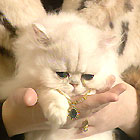Breed: Chinchilla cat
Temperament: placid and affectionate
Cost: from $650 to around $850
Lifespan: 12-15 years
Maintenance: high
Recommended for: elderly, singles
History
Longhaired cats hold a special place in many cat lover’s hearts, and perhaps none more so than the Chinchilla. Often regarded as the most beautiful of all longhairs, the Chinchilla, with its white coat lightly tipped with contrasting hues and its piercing emerald green eyes, is the epitome of feline grace. However the breed’s lofty reputation is somewhat offset by the origins of its name. The Chinchilla name is in fact derived from a South American native rodent, which shares the same coat characteristics.
The Chinchilla is actually just one variety of Persian – a particular type of cat whose early origins lay in Persia (modern-day Iran) and now typified by a profuse long coat, large round head and shortened face. Apart from the Chinchilla, there are more than 60 varieties and colour variations of Persian.
Appearance
Chinchillas portray a certain elegance characterised by the long, thick, silky coat, a large face and expressive eyes. The profuse coat should be white, though lightly tipped with either black, silver or gold to give a shimmering, translucent appearance. This tipping is usually restricted to the head, back, legs, tail and flanks whilst the underbelly should be pure white. Those Chinchillas tipped with silver are called shaded silvers whilst those with gold tips are called shaded goldens – although these are quite rare in Australia.
Both the eye-rims and nose are outlined in black, providing a stark contrast to the emerald green eyes and red nose.
Temperament
Anyone who has seen the 1971 James Bond film ‘Diamonds are Forever’ will remember Bond’s arch enemy, Blofeld, lovingly stroking a Chinchilla whilst he and his feline companion calmly plotted world domination. This image accurately portrays the Chinchilla – perhaps not so much the world domination part (although you can never tell what is going through your cat’s mind), but rather the placid, quiet animal most content when on the receiving end of adoring attention from its owner. Chinchillas are an attentive and loving breed, and usually become very attached to their owners.
Grooming
If you love the look of a Chinchilla, but are not prepared to put in the work maintaining its coat, then think twice before buying. Chinchillas are a high maintenance animal, the coat sheds heavily and requires brushing daily to prevent knotting and matting. Bathing at least once a month is also highly recommended. Cats and water don’t normally go well together, so introduce the kitten at a young age, about 6 weeks. If a Chinchilla’s coat is left unattended, apart from looking unsightly and difficult to brush later, the matting can cause the animal discomfort and pain. Heavily knotted coats can often require clipping, and as this attention is often resented by the cat, this may need to be done under general anesthetic by a veterinary surgeon. During routine grooming particular attention should be paid to those areas where fur may rub, especially under the tail, belly and underarm.
Health and lifespan
The long coat may also predispose the cat to other health concerns. Furballs, common amongst longhaired breeds, are best avoided by routinely supplementing the meal with a very small quantity of cooking oil or margarine; no more than five millilitres. The long hair surrounding the eyes can also trap foreign matter which may cause irritation. This area should be wiped with a soft, clean cloth. The shortened face can also lead to blocked tear ducts, which can only be corrected with veterinary attention. Longhaired cats are prone to polycystic kidney disease though responsible breeders are now testing for this condition. Severely affected kittens will usually not survive more than several weeks whilst chronic sufferers will also eventually succumb to the disease. Healthy Chinchillas will live around 12-15 years.
Breeding and cost
Chinchillas average four kittens per litter. Kittens may be born dark with tabby markings but this should fade as the fur grows. Chinchilla kittens cost around $650-$850.
Ideal owner
Chinchillas are often owned by older people who have time to care for the cat and want an affectionate companion. Keep in mind that very young children may be tempted to pull the cat’s hair, and albeit a very tolerant breed, the Chinchilla is likely to resent this type of attention. The heavy coat does shed profusely, especially during the warmer months, and will cover upholstery and clothes. The coat also best suits the breed to cooler zones, and clipping may be advised if you live in very hot areas. Many Chinchillas prefer to spend much of their time indoors and are ideally suited to townhouses and apartments. They are a wonderfully loving breed and will return any attention paid to them with great affection and devotion.
Further information
For more information about Chinchillas and breeders in your state, contact Glenda Simmons, President of the Silver Cat Club of Australia (02) 4684 1730 or www.caloolasilvers.net.



